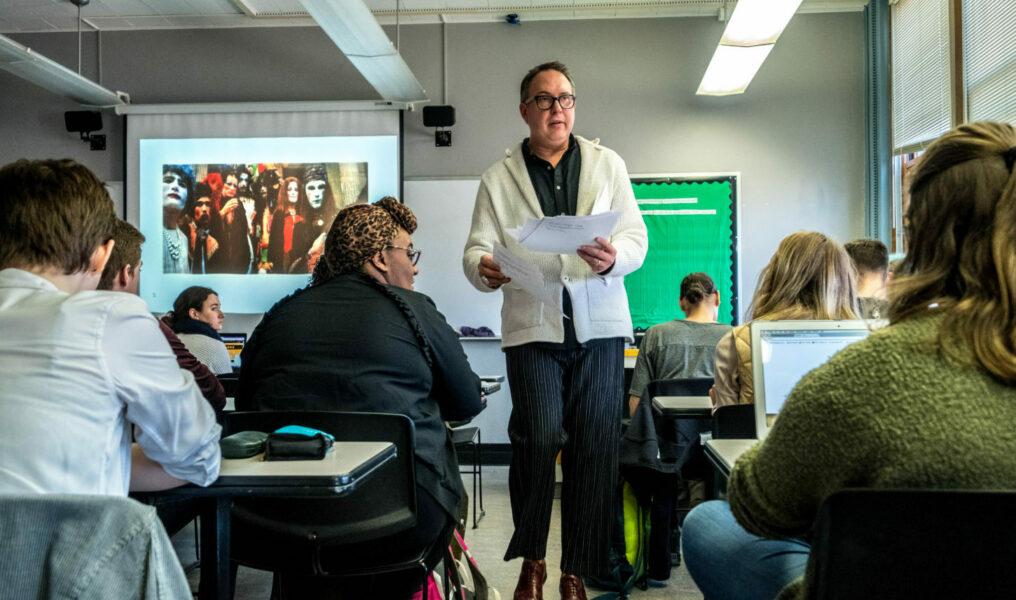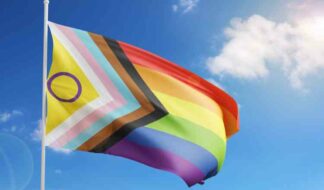With a history of designers like Cristobal Balenciaga, Bob Mackie and Karl Lagerfeld it's impossible to dispute the LGBTQ community's impact on the world of modern-day fashion. But as famous as those names are, along with dozens of others like them, it's startling how little research has been done on the LGBTQ community's overall involvement in the fashion industry. Dr. Michael Mamp, a professor of fashion, interior design and merchandising at Central Michigan University, certainly thought so when he put together his "Queer Fashion" course.
"Fashion has always fought a battle of being considered frivolous, but when you consider the history of fashion and really, within my field we refer to it as dress from a scholastic perspective, there's so much that we can learn from what people have worn and what they've chosen to wear over time," Mamp said.
Mamp said that he first got the idea for his course in 2013 when he went to the Fashion Institute of Technology in New York City for a museum exhibit called "A Queer History of Fashion from the Closet to the Catwalk."
"And that exhibit explored the relationship between fashion in the queer community and mostly from a couture, very high-end perspective. And when I saw that exhibit and the subsequent catalog that came out from it, my wheels started to turn and I was thinking how could I do something that took 'A Queer History of Fashion from the Closet to the Catwalk' where they left off, and maybe still talk about some of those components of high-end fashion. Because I do think people are interested in that," he said. "But also, how clothing, in general, has really helped to shape and express queer identity over time."
That began an intense process of research that traced LGBTQ fashion influences to as far back as the 18th century. Mamp provided an example of Marie Antoinette, who by many is considered a fashion icon for her extravagant gowns and wigs, but who was also lambasted for her choice to wear male-inspired riding jackets and pants.
"We remember her for this made-up phrase of, 'Let them eat cake,' but she wore pants. She had a woman paint her portrait," Mamp said. "… And because she wore those garments people accused her of being a lesbian."
The trajectory of Mamp's curriculum extends into present-day. He said that students really become engaged when they can see some of the course's topics represented in their day-to-day experiences like through social media. Mamp gave an example of a student sharing a tweet with the class that observed many male attendees of this year's New York Fashion Week wearing heels.
"I think the students then feel validated and they're looking in the zeitgeist for expressions of queer identity through dress and then they bring that to the classroom," he said. "So, that really creates this dynamic environment where I'm learning to grow from their engagement."
Vibrant Debate in Class
And with a dynamic environment comes spirited debate. Mamp said that one of the interesting elements of teaching a class that features the styles of various LGBTQ subcultures is that it forces students to reexamine their own relationships to gender identity and its presentation.
"Within our own community we value masculine traits over feminine traits. We tend to shame those that represent a femme identity over those that represent a masculine identity. So, when you start to talk about those nuances within the LGBTQ+ community the students begin to think about how they express either femininity or masculinity and how that has either been encouraged, discouraged, questioned throughout their own experiences," Mamp said. "And so, I think it opens the door for conversation across these boundaries of straight versus gay communities."
Mamp said those who do attend his course come in with "a strong desire and curiosity to learn" but where debates sometimes occur is in the discussion of sex and expressions of sexuality in relation to queer identity.
"And we talk about that in the context of dress and how people express their sexuality or sexual practice through dress. And we also talk about that through queer art, like produced by Robert Mapplethorpe or Leigh Bowery," Mamp said. "I think it's probably the first time they've had a class where they're talking about things like that. So that might be a little, for lack of a better word, shocking."
Mamp said that Bowery's work can often have that effect because his costumes played heavily with gender presentation in an effort to show it as merely a social construct. However, once the initial shock washes away, Mamp said that students tend to leave the course with positive reviews of what they've learned, for which he grateful. He added that he was surprised at the demographics of the course, too, because many students in attendance aren't LGBTQ themselves and those who are are often transgender men.
"It really spoke to me that we need to, through this course and through other courses, provide spaces and information and curriculum that address needs of trans individuals," he said.
Fashion's Historical Impact
Mamp noted that Generation Z — people aged roughly between 4 and 24 — tends not to have a traditionally binary view of gender either, which allows many of his students to be "thirsty and hungry for greater understanding" of not only the subject matter, but how fashion — consciously or not — has impacted their own experience and perspective. He gave an example of lesbian fashion made popular in the early 20th century.
"Gertrude Stein, Janet Flanner, Marlene Dietrich … all of them dressed in a mannish way by taking the suit, which is really a symbol of the patriarchy, and interpreting it and having it made and fitted for their bodies," Mamp said. "… But then in 1966 Yves Saint Laurent, a gay man, creates a suit called Le Smoking, which was on the cover of Vogue and was a huge sensation and becomes a fashion juggernaut."
Despite those positive steps for individual expression, Mamp said that because a lot of fashion trends, particularly in women's fashion, have been decided by prominent gay fashion designers, sometimes unintended negative effects have resulted.
"I kind of have a love-hate relationship with it. Dior, who was a gay man, post-World War II put women back into these very molded, sculpted, object-on-a-pedestal silhouettes," he said. "And so, I think that's why it's important that we look at how did women individually, people like those that I've mentioned, figure out ways of dressing that allowed them to function in a public sphere?"
"So, this course is sort of like a history course, a sociology course, a psychology course, but it's just told through the lens of fashion with a focus on LGBTQ+ persons," Mamp continued. "And I'm just really excited and privileged that CMU has been supportive of me offering this as a part of our curriculum."










